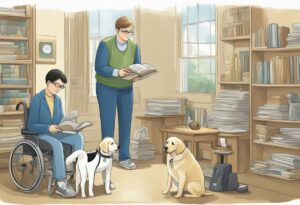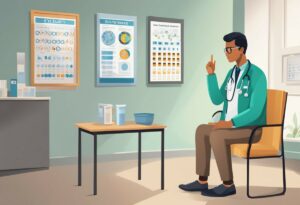Straight Facts: An Honest Review of Low Vision Software for Improved Accessibility

In today’s increasingly digital world, people with low vision often face challenges when accessing technology and reading digital content. Low vision is a permanent and significant loss of visual function that affects a person’s ability to see clearly. To address these challenges, several software applications offer support to people with low vision, helping them make the most of the digital resources at their disposal.
Low vision software programs can broadly be classified into screen magnifiers, screen readers, and specialized applications that cater to their unique requirements. As we delve deeper into the world of low vision software, it’s essential to understand the features, benefits, and limitations of these programs. By providing an honest review of low vision software, we aim to offer valuable insights that can help users make an informed decision when choosing the right tool to enhance visual accessibility.
In this article, we will cover various low vision software options, focusing on their strengths, weaknesses, and compatibility with different devices and platforms. Armed with this information, users will be better equipped to find the right solution that precisely caters to their needs, enabling them to embrace technology and stay connected with the digital world.
Overview of Low Vision Software
Definition
Low vision software is a category of assistive technology specifically designed to aid individuals with visual impairments, including those who are blind or have low vision. These tools help users with limited visual acuity or restricted visual fields to access digital content and navigate computers, smartphones, and other electronic devices with greater ease and independence.
Common Features
- Magnification: One of the primary functions of low vision software is to magnify on-screen content, making it easier for users with low vision to read and interact with digital text. Software like ZoomText offers multiple levels of zoom and customization options to suit individual needs.
- Speech Output: Many low vision software programs include text-to-speech functionality, converting on-screen text, documents, and web content into audible speech for individuals who are blind or prefer auditory information processing.
- Visual Accessibility Features: Low vision software often includes settings such as high-contrast colors, custom fonts, and adjustable cursor size to enhance visibility and adapt to the user’s unique visual preferences.
- Braille Support: For users who are blind and proficient in Braille, low vision software may be compatible with Braille display devices that translate digital text into refreshable Braille patterns. Integrating Braille support enables blind individuals to read and write as independently as their sighted counterparts.
- Keyboard and Gesture Adaptation: To aid in seamless navigation, low vision software may come with modified keyboard shortcuts, tactile feedback options, or adapted touchscreen gestures to accommodate users’ visual acuity or field limitations.
In conclusion, low vision software plays a crucial role in making digital content more accessible to individuals with visual impairments. By offering features such as magnification, speech output, and customizable accessibility settings, these programs empower users with diverse visual needs to navigate and interact with the digital world more comfortably and independently.
Causes and Diagnosis of Low Vision
Common Causes
Low vision is usually caused by eye diseases or conditions that disrupt normal visual function. Some of the most common causes of low vision include:
- Age-related macular degeneration (AMD): This is a leading cause of low vision in older adults and affects the center of the retina, responsible for sharp, central vision.
- Glaucoma: This condition damages the optic nerve and can lead to blind spots, tunnel vision, and total vision loss if left untreated.
- Diabetic retinopathy: Resulting from complications of diabetes, this condition affects the blood vessels in the retina and may cause fluctuating or blurry vision, impaired color perception, and vision loss.
- Cataracts: This cause clouding of the eye’s lens, leading to blurry or dim vision.
Diagnosis Process
To diagnose and determine the cause of low vision, a comprehensive eye exam is necessary. This exam may involve several tests and assessments, such as:
- Visual acuity test: This common eye test measures how well a person can see at various distances using a chart with different-sized letters or symbols.
- Visual field test: This test measures the peripheral, or side, vision to help identify any blind spots or areas of reduced vision.
- Tonometry: This test measures the pressure inside the eye, which can help detect glaucoma or other issues.
- Dilated eye exam: During this exam, eye drops are used to widen the pupil, allowing the doctor to examine the retina and optic nerve more thoroughly.
The American Optometric Association recommends regular eye exams for early detection and proper management of low vision. By understanding the causes and diagnosis process, individuals can seek appropriate treatment and make informed decisions about low vision software solutions.
Assistive Technology for Low Vision
Assistive technology for low vision includes a range of devices and software solutions designed to help individuals with visual impairments perform daily tasks, enhance their employment and recreation opportunities, and maintain independence. This section provides an overview of some of the most common low vision assistive technologies, including magnification tools, screen readers, and specialty devices.
Magnification Tools
Magnification tools are essential for many individuals with low vision. These tools help enhance the size and clarity of text and images, allowing users to read, browse the internet, or perform other tasks on computers and mobile devices with more ease. Some popular magnification tools include:
- Handheld magnifiers: Portable devices that provide a magnified view of text, photos, or other objects.
- Glasses with magnification: Special glasses can assist with reading and other close-up tasks.
- Zoom features on computers and mobile devices: Built-in software options to enlarge the screen or specific sections of content.
- High contrast settings: Customization options that improve readability by exaggerating the difference between text and background colors.
These tools can be customized to suit an individual’s specific needs, such as magnification level, contrast sensitivity, and preferred style.
Screen Readers
Screen readers are crucial for those who have more severe visual impairments or legal blindness. These software solutions convert on-screen text into spoken output, allowing users to listen to the content instead of reading it visually. Some popular screen readers include:
- VoiceOver on iOS devices: Exclusive to Apple devices like the iPhone and iPad, this built-in screen reader utilizes touchscreen gestures to navigate content and read aloud selected text.
- Other screen reader software: Available on various computer systems, these applications provide similar functionality to VoiceOver and allow users to interact with their devices through text-to-speech output.
Screen readers have become increasingly sophisticated over the years, offering more advanced features and seamless integration with various devices and operating systems.
Specialty Devices
In addition to more common technologies like magnifiers and screen readers, there are specialty devices designed to address specific challenges faced by individuals with low vision. Some examples include:
- Braille displays: These devices connect to computers or mobile devices and translate on-screen text into Braille output, allowing users who are blind or have very low vision to read content.
- Reading machines: Stand-alone devices that can scan printed text and convert it into spoken output, assisting users in reading books, documents, and other materials.
- GPS navigation tools: Some devices or applications offer specialized voice guidance and other features tailored to those with visual impairments, providing enhanced independence in outdoor navigation.
Each person’s requirements and preferences may vary, so it’s essential to explore the variety of low vision assistive technologies to find the perfect solution. Advances in technology continue to bring new opportunities for improved accessibility and independence for individuals with low vision.
Adapting to Low Vision in Everyday Life
Living with low vision can be challenging, but by implementing certain strategies and modifications, individuals with conditions like macular degeneration or sight loss can enhance their quality of life and maintain their independence. The following sub-sections discuss home and workplace modifications and recreational activities adjustments that can help partially sighted individuals adapt to their low vision.
Home and Workplace Modifications
Lighting: Improving lighting conditions is crucial for individuals with low vision. Ensuring well-lit spaces with adjustable or task-specific lighting can make a significant difference in performing daily activities. Consider installing:
- Bright, directed light sources to enhance visibility.
- Dimmable lamps for customizable lighting levels.
Contrast: Enhancing contrast can make navigating the space and identifying objects easier. Some ways to improve contrast include:
- Using bold, high-contrast colors for walls, furniture, and objects.
- Outlining edges of steps, doors, and furniture with contrasting tape.
Organization: Keeping the home and workplace organized can help avoid accidents and make daily tasks more manageable. Some tips for organization include:
- Labeling items and appliances with large, clear text.
- Keeping frequently used items within easy reach.
- Creating designated areas for everyday items.
Recreational Activities
Living with low vision shouldn’t limit one’s ability to engage in enjoyable activities. There are several recreational adaptations that can be made to accommodate vision impairment.
Sports: Many sports can be adapted for low vision individuals by using specialized equipment or incorporating specific modifications:
- Goalball, a sport designed for visually impaired players, uses a ball with bells inside.
- Running with a sighted guide using a tether can ensure safe navigation.
Arts and Entertainment: Pursuing hobbies and enjoying entertainment is still possible for those with low vision. Some suggestions for adapting to vision loss in these areas include:
- Taking advantage of audio-described movies, theater productions, and museum tours.
- Using large-print or digital versions of books, newspapers, and magazines, which can be easily adjusted for font size and contrast.
In summary, adapting to low vision in everyday life requires a combination of home and workplace modifications, as well as finding ways to maintain participation in recreational activities. By focusing on these adjustments, partially sighted individuals can continue to lead fulfilling and independent lives.
Conclusion
In summary, there are several low vision software options available on the market that can greatly benefit individuals with vision impairments. These software programs typically offer features such as text-to-speech, magnification, and contrast adjustments to provide a more accessible experience. One example of a popular vision software is Speech Technologies for Blind and Low Vision Persons.
It’s important to consider the specific needs of the user when choosing a low vision software, as different programs may have varying features and capabilities. Key factors to consider when selecting a low vision software include:
- Ease of use
- Accessibility features
- Compatibility with devices and operating systems
- Cost and availability
As technology continues to advance, it’s worth staying updated on new developments and improvements in low vision software. Resources such as the National Academies of Sciences, Engineering, and Medicine provide valuable insights into the efficacy of these software programs, with evidence supporting the benefits of vision rehabilitation.
Ultimately, the right low vision software can make a significant difference in the lives of individuals with visual impairments, making it essential to carefully evaluate their options and choose a solution that meets their needs.
Frequently Asked Questions
What are the key features of Low Vision Software?
Low vision software typically includes features such as screen magnification, high contrast modes, and customizable text sizing to make it easier for individuals with low vision to access and interact with digital content. Some software also offers text-to-speech functionality to provide an auditory alternative to reading text on screen.
How does Low Vision Software?
compare to other solutions?
Compared to traditional magnifying devices or large-print materials, low vision software offers more flexibility and customization options. It can be tailored to the specific needs and preferences of the user, making it a more personalized solution. Moreover, software solutions can be easily updated and adapted to work with new digital content and platforms as they emerge.
Are there any compatibility issues to consider?
Compatibility issues may arise with certain low vision software solutions, particularly when it comes to operating systems or specific applications. It is essential to research and test a software’s compatibility with your preferred devices and software applications before purchasing. Some low vision software may also offer different versions or add-ons to address compatibility concerns.
What is the cost of Low Vision Software?
The cost of low vision software can vary widely, depending on the specific product and its features. Some solutions may be available as free or low-cost options, while others may require a one-time purchase or a subscription fee. It is important to consider your budget and the specific features you need when evaluating different software solutions.
Can this software help improve peripheral vision loss?
While low vision software can help individuals with peripheral vision loss by providing personalized display settings and screen magnification, it is not designed to improve or restore peripheral vision itself. The main goal of the software is to make digital content more accessible and readable for individuals experiencing vision loss.
Is there a trial version or demo available for Low Vision Software?
New England Low Vision and Blindness is pleased to offer the latest and most advanced low vision and blindness technology supported by world-class personal service. We have nearly 100% of all major electronic low vision, blindness, and software products. Our complimentary, no-obligation demonstration on any of our products will make sure our clients are getting the right product for their specific eye condition. Click here to learn more.
New England Low Vision and Blindness also offers Assistive Rehabilitation Training Services for people with low vision and blindness. We go to our clients – home, school, or business – training where they need it – from caring assistive technology professionals. Click here to learn more.



